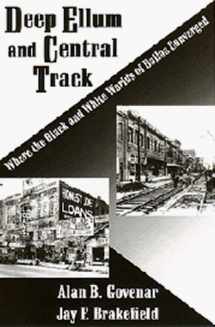
Deep Ellum and Central Track: Where the Black and White Worlds of Dallas Converged
Book details
Summary
Description
Local histories are of far more than regional significance, particularly when the data relate to larger scenes, as is true in this study of Dallas's early-20th-century Jewish and Black ghettos--Deep Ellum and Central Track. The two groups had migrated to Dallas, individually expecting the traditions of segregation, a situation that brought about some degree of alliance. Sociological concerns do play a part in Govenar's coverage (including politics, economics, and crime), but his real subject is blues--an idiom that began to come into focus late in the 19th century and blossomed with Texan Blind Lemon Jefferson (1893-1929) and those who came under his influence. Although Govenar provides a very respectable bibliography, the majority of the footnoted sources are interviews, suggesting much of the information has not previously appeared in print. Included in the four appendixes are discographies of Dallas-related jazz, blues, gospel, and country and of the Light Crust Doughboys, a popular music ensemble active in the late 1930s (in fact, these two appendixes occupy more than a third of the book). Numerous photographs are also included. This will be a welcome addition to collections supporting study of the blues and of the US Southwest. Choice Magazine, May 1999. Review by D. R. de Lerma, Lawrence University.
"Through a mixture of contemporary interviews and historical research, Govenar and Brakefield provide us with a compelling portrait of Deep Ellum, a complex and often misunderstood section of Dallas. The nexus for many East Texas musicians during the 1920s and 1930s, Deep Ellum was a helter skelter mixture of clubs, pawnshops, and other small businesses that attracted the entire spectrum of vernacular musicians. This book is important not only for what it reveals about local blues, gospel, jazz, and western swing performers but for what it tells us about race relations and other poorly researched aspects of the city's social history." --Kip Lornell, George Washington University, & the Smithsonian Institution
"Like Beale Street in Memphis and Bourbon Street in New Orleans, Deep Ellum in Dallas, Texas, was famed in song and legend for its nightlife as well as its thriving daytime commerce. It was also a place in the segregated South where the races met in ways that they couldn't elsewhere. In the work of Govenar and Brakefield, Deep Ellum now takes its place in these other important southern urban districts of the early twentieth century."--David Evans, Professor of Music, The University of Memphis
"Alan Govenar is a gifted and meticulous researcher whose works are notable for a passionate respect for his subject. In its thoroughness and insight, Deep Ellum deepens our understanding of African-American music by re-connecting the art to its material base. It's a reminder that Harlem is only one chapter in the renaissance of African-American culture."--Lorenzo Thomas, University of Houston-Downtown


We would LOVE it if you could help us and other readers by reviewing the book
Book review



